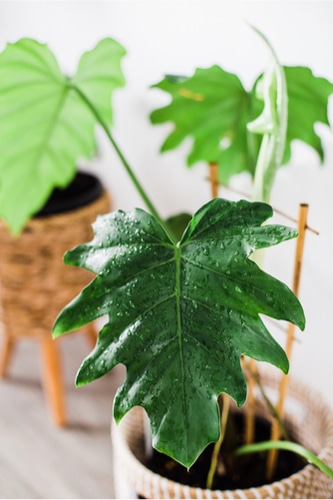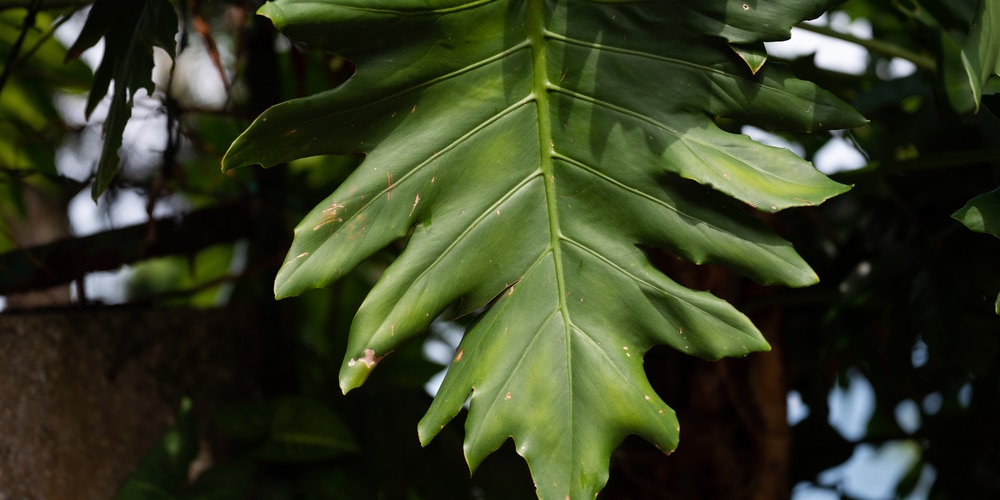Philodendron lacerum is a tropical houseplant that is closely related to philodendron selloum. In the wild, this species can be found growing throughout Costa Rica and Panama. It prefers moist, shaded habitats in forested areas.
Philodendron lacerum is a large plant that can grow up to 30 feet tall if unobstructed. When grown as a houseplant, it will be more compact. The plant’s leaves are large and glossy, which is how the plant gets its common nickname, elephants ear plant. If properly cared for, philodendron lacerum should only need minimal attention to maintain its health. Let’s look at how to grow and care for a plant that will thrive for many years to come.
What is a Philodendron Lacerum?
The Philodendron lacerum is part of the Araceae family and grows from rhizomes. It can grow up to 30 feet tall and has large leaves with sawtooth edges. These plants can be grown indoors and look great in the corner of a large room. They also do well outdoor in the right climate. It’s recommended that you don’t leave your plant outside year-round unless you live in USDA zones 9 to 11.
Keep your philodendron lacerum out of the reach of children and pets. All parts of the plant are poisonous if ingested. Symptoms include vomiting, diarrhea, weakness, drowsiness, and tremors. If you suspect that your dog or cat has ingested any part of your plant, take it to the veterinarian immediately.
How to Care for a Philodendron Lacerum
Philodendron Lacerums are relatively easy to care for as long as you get the basics right. These plants are perfect for beginners. Here’s how to grow a thriving Philodendron Lacerum:
Sunlight needs
Philodendron lacerum prefers bright indirect light at all times; your plant should never be exposed to direct sunlight. If placed too close to a window (within 1 foot), the leaves will wilt and become discolored due to overexposure.
The philodendron lacerum can be grown successfully indoors under fluorescent lights. The key to growing lacerum under artificial light is to ensure that the plant receives a minimum of 12 hours of light per day.
Watering Requirements
Like other philodendrons, philodendron lacerum should never be allowed to dry out completely. Only let the topsoil dry out, and always test the soil with your finger before watering.
You should also avoid over-watering your plant as this can result in root rot. Never allow water to collect in the rosette of the leaves, as this will promote disease.
Humidity
Maintaining humidity at around 50% to 70% is recommended for all philodendrons, but lacerum does especially well in a moist environment. If you have an ultrasonic humidifier, it can be set to mist every 1-2 hours to increase your plant’s humidity. Alternatively, place your plant in a bathroom or kitchen as these rooms have naturally higher humidity. Other ways of improving humidity include misting, grouping tropical plants, or using a water and pebble tray.
Temperature
Philodendrons are adaptable in terms of temperature, except freezing temperatures. For Philodendron lacerum, daytime temperatures should range from 65 F to 85 F, with a nighttime temperature of 55F. If lower temperatures are encountered, the plant should be moved to a warmer location.
Fertilization
Philodendrons require fertilizer every month during the spring and summer. To fertilize, dilute one-half of the recommended dose with water and apply to the soil.
Soil and Repotting
Lacerum generally needs re-potted only once every 3 to 4 years. If you choose to report your plant, do so during the spring. Use soil that’s composition is 60% organic material, 25% peat moss, and 15% coarse sand. A slightly acidic soil with a pH of between 5.0 and 6.0 is recommended.
Pruning
Lacerum plants generally do not require pruning. If you choose to prune your plant, it should be done in late winter or early spring. To do so, remove a few of the stem sections at various levels on the plant. It is best to allow larger leaves to remain intact while smaller leaves are removed.
Pests and Diseases
Philodendrons are generally pest-free, but aphids and mealybugs can attack them. To get rid of these pests, wipe the plant with a cotton swab dipped in rubbing alcohol. If your philodendron is attacked by spider mites or scale, use insecticidal soap to kill them. Scale is easy to detect, as it appears as a series of raised bumps on the leaves and stems.
Conclusion
Philodendron lacerum is an attractive plant that requires very little attention to keep it healthy. The above instructions will help you maintain your philodendron lacerum for many years to come.
Related:

